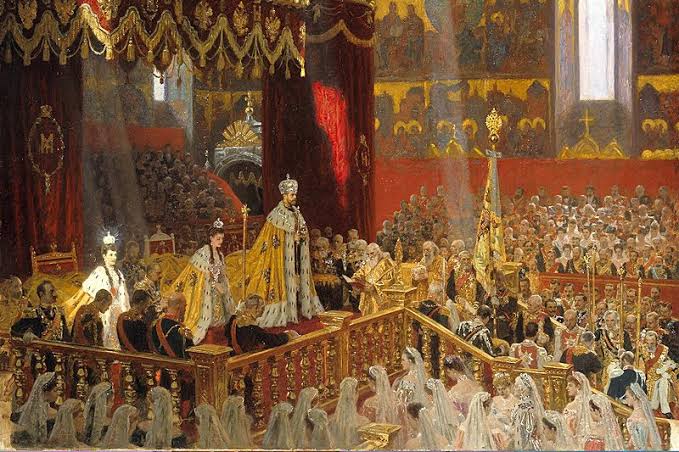The Golden Age of Imperial Russia: The Guiding Lights of Tsarist Aristocracy
In the heart of Eastern Europe, a magnificent empire once stretched across the vast expanse of the Eurasian continent, an empire of grand palaces, breathtaking landscapes, and a cultured aristocracy that would leave an indelible mark on history. This was Imperial Russia, a place where art, culture, and science thrived

In the heart of Eastern Europe, a magnificent empire once stretched across the vast expanse of the Eurasian continent, an empire of grand palaces, breathtaking landscapes, and a cultured aristocracy that would leave an indelible mark on history. This was Imperial Russia, a place where art, culture, and science thrived amidst the glittering courts of the tsars and tsarinas. The influential elite of this era, composed of the nobility, industrialists, and intellectuals, played a significant role in shaping the Russia we know today.
The nobility, graced with titles of counts and countesses, dukes and duchesses, prince and princesses, lived in opulence that reflected the grandeur of Imperial Russia. They were not only renowned for their immense wealth and political power, but also for their contributions to the arts and culture. Their patronage supported the creation of some of Russia's most enduring works of art, music, and literature.
Industrialists, on the other hand, propelled Russia into an era of unprecedented growth and modernization. Visionaries like Savva Mamontov and Pavel Tretyakov significantly influenced the Russian economy, while also promoting arts and culture. Their tireless efforts resulted in significant advancements in Russia's industrial sector, transforming it into a major global power.
The intellectuals of the period, luminaries such as Fyodor Dostoevsky, Anton Chekhov, and Ivan Turgenev, crafted literature that transcended boundaries and still resonates with readers worldwide. In the realm of music, Pyotr Tchaikovsky composed symphonies that continue to captivate audiences, while scientists like Dmitri Mendeleev, the creator of the periodic table, contributed profoundly to the field of science.
Despite the eventual downfall of the empire in the aftermath of the 1917 revolution, the legacy of the Imperial era continues to permeate Russian society and beyond. The contributions of the Tsarist elite, their ambition, vision, and creativity, continue to resonate throughout history, influencing the realms of art, literature, science, and industry.
The story of the Imperial Russian elite is a testament to the transformative power of a society's upper echelons. Their tale serves as a reminder that our past shapes our present and future. It is a story of power, wealth, and creativity, but also one of conflict, contradictions, and change. The legacy they left behind continues to remind us of a time when Russia stood as a beacon of grandeur and cultural sophistication, a testament to the enduring allure of the Tsarist era.
As the world moved into the 20th century, the influence of the Russian elite began to be felt far beyond the nation's borders. The cultural exchange between Russia and the rest of the world was notable, with Russian literature, music, and art appreciated worldwide. This was in no small part due to the efforts of the nobility, industrialists, and intellectuals who championed their nation's creative output.
Even as they embraced Western influences, these elites worked tirelessly to maintain a distinctly Russian character in their works. This blend of international and national influences helped foster a unique Russian style that continues to captivate audiences around the globe.
In many ways, the impact of these elites extended well beyond the arts and industry. They played a critical role in shaping public discourse, participating in the political debates of their day, and pushing for social and economic reforms. Their impact on Russian society was profound and wide-reaching, influencing everything from education to healthcare, from labor laws to civil rights.
But the influence of the Tsarist elite was not without its challenges. The vast wealth and power of the nobility and industrialists often stood in stark contrast to the poverty and hardship faced by much of the Russian populace. This disparity played a significant role in shaping the political and social upheavals that would eventually lead to the end of the Tsarist era.
Yet despite these challenges, the legacy of the Russian elite endures. Their contributions to art, culture, industry, and social reform continue to shape Russia and the world. Their story is a powerful reminder of the impact that a small group of dedicated, visionary individuals can have on their nation and the world.
To this day, the memory of the golden age of Imperial Russia continues to captivate. The grandeur of the palaces, the beauty of the artworks, the brilliance of the literature and music, all serve as enduring reminders of a time of great cultural flourishing, a time when the Russian elite played a pivotal role in shaping their nation's destiny.
If you'd like to delve even deeper into the intricacies of Russian history and the Tsarist era, there are countless more tales to tell. For instance, the extensive patronage of the arts and culture by the nobility helped foster a thriving creative scene that brought forth renowned talents like Fyodor Dostoevsky, Leo Tolstoy, and Anton Chekhov, whose works continue to resonate globally.
Furthermore, the splendor of Imperial Russia wasn't limited to palatial architecture and grand operas. It was also evident in the fields of science and technology, with the country producing remarkable inventors and scientists such as Dmitri Mendeleev, the creator of the Periodic Table, and Ivan Pavlov, the father of classical conditioning in psychology.
However, it is also worth remembering that the vast divide between the elite and the commoners, the spectacular wealth and the stark poverty, created tension and unrest. These social inequities set the stage for the tumultuous events of the 20th century, including the Revolution of 1917, which brought an end to the Tsarist regime and reshaped the nation.
Thus, while the Tsarist era was indeed a time of grandeur and achievement, it was also marked by conflict and struggle. The tales of the Tsarist elite and the common people intertwine in a complex tapestry of beauty, ambition, and discord—a richly textured chapter of history that continues to fascinate and instruct.
In conclusion, the legacy of the Russian Tsarist era and its elite is complex, multifaceted, and enduring. Even in the face of challenges and upheavals, their contributions have left an indelible mark on global history, offering valuable lessons and insights that continue to resonate today.




